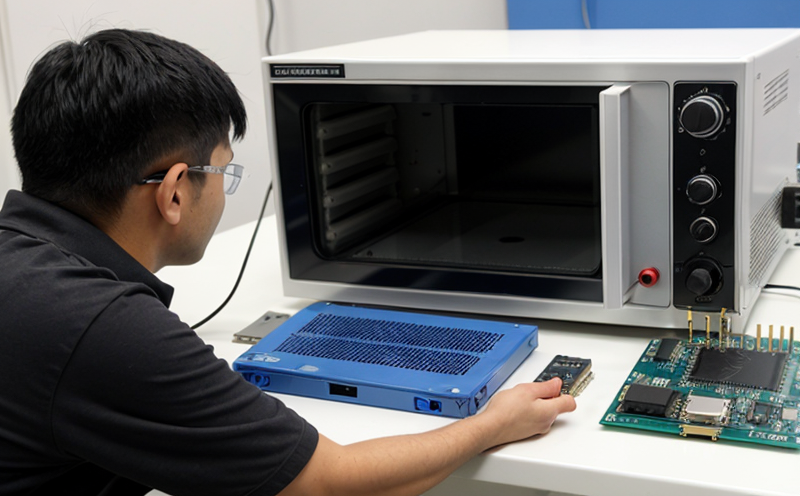JIS C 62228 EMC Testing for Integrated Circuits in Japan
The JIS C 62228-1:2017 standard outlines the methods and procedures for electromagnetic compatibility (EMC) testing of integrated circuits (ICs). This test is crucial for ensuring that electronic devices comply with relevant Japanese regulatory requirements. EMC refers to a device's ability to operate properly in its electromagnetic environment without causing unacceptable interference to other devices.
Electronics manufacturers, especially those operating in the Japanese market or exporting products to Japan, must ensure their integrated circuits meet these stringent standards. The testing process involves evaluating how well an IC can perform both as a source of and as a receiver of unwanted electromagnetic energy. This ensures that the device does not emit interference that could disrupt other electronic devices.
The test procedure is designed to assess the compliance with the limits specified in JIS C 62228-1:2017 for radiated emissions, conducted emissions, and immunity against these types of electromagnetic disturbances. The testing process typically involves several stages:
- Preparation and setup of the test environment
- Calibration of test equipment to ensure accurate measurements
- Conducting the EMC tests on the IC according to specified parameters
- Data acquisition and analysis
- Evaluation against the relevant limits as per JIS C 62228-1:2017
The test setup includes a fully equipped EMC testing chamber that can simulate different environments such as residential, office, and industrial settings. This allows for comprehensive evaluation of the IC under various conditions it might encounter in real-world applications.
For radiated emissions tests, the chamber is used to measure the electromagnetic field strength emitted by the IC at specific frequencies. Conducted emissions testing focuses on measuring the current flowing through the power and signal lines during operation. Immunity testing assesses how well the device can function when exposed to various levels of interference.
Preparation of the specimen includes ensuring that all external connections are properly made, and any necessary shielding is in place. The specimen must be tested under specified conditions, including temperature, humidity, and voltage supply. This ensures a fair and consistent testing environment.
The test results are documented meticulously and compared against the limits set by JIS C 62228-1:2017. Compliance with these standards is essential for manufacturers to avoid potential issues in the market or during certification processes.
For quality managers, compliance officers, R&D engineers, and procurement teams, understanding this testing process is crucial. It helps them ensure that their products meet regulatory requirements and perform reliably under expected electromagnetic conditions.
Applied Standards
JIS C 62228-1:2017 is one of several international standards used to assess the EMC performance of electronic devices. In addition to this standard, other relevant standards include:
- IEC 61000 series
- ANSI/IEEE standards for EMC
- CENELEC EN 50214
The choice of standard can vary based on the specific requirements of the market or region. However, JIS C 62228-1:2017 is particularly important for Japanese manufacturers and those targeting the Japanese market.
Understanding these standards helps ensure that products are designed to meet global expectations and regulatory compliance. Compliance officers should familiarize themselves with these standards to guide their organizations in achieving successful product launches and maintaining market presence.
Industry Applications
The application of JIS C 62228-1:2017 is extensive, covering a wide range of industries where electronic components are critical. Key sectors include:
- Automotive electronics
- Consumer electronics
- Medical devices
- Telecommunications equipment
In the automotive industry, ensuring that ICs meet EMC standards is vital for preventing malfunctions in critical systems such as braking and steering. In consumer electronics, compliance helps prevent interference with other household appliances. For medical devices, it ensures safe operation without disruption from external electromagnetic sources.
The telecommunications sector relies heavily on robust EMC testing to ensure reliable communication networks. By adhering to JIS C 62228-1:2017, manufacturers can enhance the performance and reliability of their products across various industries.
Eurolab Advantages
At Eurolab, we pride ourselves on providing comprehensive EMC testing services that meet the highest standards. Our team of experts ensures that every test is conducted in compliance with JIS C 62228-1:2017 and other relevant international standards.
- State-of-the-art facilities: Our testing chambers are equipped with the latest technology to simulate real-world electromagnetic environments accurately.
- Experienced staff: Our team comprises highly skilled professionals with extensive experience in EMC testing and compliance.
- Comprehensive reporting: We provide detailed reports that not only document test results but also offer valuable insights into potential areas for improvement.
- Global network: Leveraging our global network, we can assist clients in navigating local regulations and requirements effectively.
Our commitment to quality and customer satisfaction ensures that our services meet the rigorous demands of the Japanese market. Quality managers and compliance officers can rest assured knowing that their products are tested by experts who understand the unique challenges and requirements of the industry.





